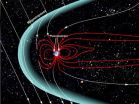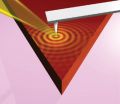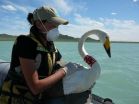(Press-News.org) In the giant system that connects Earth to the sun, one key event happens over and over: solar material streams toward Earth and the giant magnetic bubble around Earth, the magnetosphere helps keep it at bay. The parameters, however, change: The particles streaming in could be from the constant solar wind, or perhaps from a giant cloud erupting off the sun called a coronal mass ejection, or CME. Sometimes the configuration is such that the magnetosphere blocks almost all the material, other times the connection is long and strong, allowing much material in. Understanding just what circumstances lead to what results is a key part of protecting our orbiting spacecraft from the effects of such space weather.
Now, for the first time, a study shows that in certain circumstances a pool of dense particles normally circling Earth, deep inside the magnetosphere, can extend a long arm out to meet – and help block – incoming solar material.
"It's like what you might do if a monster tried to break into your house. You'd stack furniture up against the front door, and that's close to what the Earth is doing here," said Brian Walsh, a space scientist at NASA's Goddard Space Flight Center in Greenbelt, Md. "The material that is usually much nearer Earth stacks up against the outer boundary of the magnetosphere, throttling the interaction there and stopping solar material from entering."
In the March 6, 2014, issue of Science Express, Walsh and his colleagues compared observations from the ground and in space during a solar storm on Jan. 17, 2013. This was a fairly moderate solar storm caused by a CME impacting Earth's magnetosphere for several hours. As the CME encountered the boundary of the magnetosphere, its magnetic fields and those around Earth realigned in a process called magnetic reconnection, which allowed energy and solar material to cross the boundary into the magnetosphere. NASA's three THEMIS – for Time History of Events and Macroscale Interactions during Substorms – spacecraft were in the right place at the right time, flying through the magnetosphere's boundary approximately 45 minutes apart, and caught this interaction.
Closer to Earth, scientists could also study the sphere of cold dense gas at the very top of our atmosphere. This region is called the plasmasphere and it's made of what's known as plasma, a gas made of charged particles. GPS signals travel through the plasmasphere and they travel at different speeds depending on how thick or thin the plasmasphere is along the journey. Tracking the GPS radio signals, therefore, can help researchers map out the properties of the plasmasphere.
"A colleague who works with these kind of observations said I had to see some interesting data showing a plume from the ground," said Walsh. "And I typed in the dates and saw that it was a date when THEMIS was in the right position. So, for the first time, we could make a comparison."
THEMIS showed that the tongue of this cold, dense plasmasphere material stretched all the way up to the magnetic reconnection point where the CME had made contact with the magnetopause. The three sets of THEMIS observations demonstrated that the plume had a dramatic impact on the characteristics of the magnetic reconnection region.
"It wouldn't work if the magnetic reconnection happened for only a few minutes," said David Sibeck the project scientist for THEMIS at NASA Goddard. "But if it lasts long enough, the whole magnetosphere gets involved. This tongue of the plasmasphere surges out, adding another layer of protection, curbing the magnetic reconnection."
As scientists try to better understand the space weather system around Earth, they rely on multipoint observations such as this to connect what's seen on the ground to what's seen in space. In this case THEMIS data connected to GPS data, but such combinations are increasingly being used to watch how Earth is affected by its closest star. Eventually such observations could lead to improvements in space weather predictions, which would be as useful for spacecraft operators as terrestrial weather forecasts are for us here on Earth.
INFORMATION:
For more information about NASA's THEMIS mission, visit:
http://www.nasa.gov/themis
NASA's THEMIS discovers new process that protects Earth from space weather
2014-03-06
ELSE PRESS RELEASES FROM THIS DATE:
Crystals ripple in response to light
2014-03-06
Light can trigger coordinated, wavelike motions of atoms in atom-thin layers of crystal, scientists have shown. The waves, called phonon polaritons, are far shorter than light waves and can be "tuned" to particular frequencies and amplitudes by varying the number of layers of crystal, they report in the early online edition of Science March 7.
These properties - observed in this class of material for the first time - open the possibility of using polaritons to convey information in tight spaces, create images at far finer resolution than is possible with light, and manage ...
Plasma plumes help shield Earth from damaging solar storms
2014-03-06
The Earth's magnetic field, or magnetosphere, stretches from the planet's core out into space, where it meets the solar wind, a stream of charged particles emitted by the sun. For the most part, the magnetosphere acts as a shield to protect the Earth from this high-energy solar activity.
But when this field comes into contact with the sun's magnetic field — a process called "magnetic reconnection" — powerful electrical currents from the sun can stream into Earth's atmosphere, whipping up geomagnetic storms and space weather phenomena that can affect high-altitude aircraft, ...
Researchers calculate how river networks move across a landscape
2014-03-06
Large river networks — such as those that funnel into the Colorado and Mississippi rivers — may seem to be permanent features of a landscape. In fact, many rivers define political boundaries that have been in place for centuries.
But scientists have long suspected that river networks are not as static as they may appear, and have gathered geologic and biological evidence that suggest many rivers have been "rewired," shifting and moving across a landscape over millions of years.
Now researchers at MIT and the Swiss Federal Institute of Technology (ETH Zurich) have developed ...
Warmer temperatures push malaria to higher elevations
2014-03-06
Researchers have debated for more than two decades the likely impacts, if any, of global warming on the worldwide incidence of malaria, a mosquito-borne disease that infects more than 300 million people each year.
Now, researchers from the London School of Hygiene & Tropical Medicine and the University of Michigan, with colleagues, are reporting the first hard evidence that malaria does—as had long been predicted—creep to higher elevations during warmer years and back down to lower altitudes when temperatures cool.
The study, due to be published in Science and based ...
Scientists create detailed picture of protein linked to learning, pain and brain disorders
2014-03-06
LA JOLLA, CA, and NASHVILLE, TN – March 6, 2014 – Researchers at The Scripps Research Institute (TSRI) and Vanderbilt University have created the most detailed 3-D picture yet of a membrane protein that is linked to learning, memory, anxiety, pain and brain disorders such as schizophrenia, Parkinson's, Alzheimer's and autism.
"This receptor family is an exciting new target for future medicines for treatment of brain disorders," said P. Jeffrey Conn, PhD, Lee E. Limbird Professor of Pharmacology and director of the Vanderbilt Center for Neuroscience Drug Discovery, who ...
Warmer temperatures fuel spread of malaria into higher elevations
2014-03-06
In the tropical highlands of South America and East Africa, cool temperatures have historically kept mosquito-borne diseases, such as malaria, at bay. New research by Howard Hughes Medical Institute (HHMI) scientists shows that as annual temperatures rise in these areas, malaria can spread to populations in higher elevations that had historically not been at as much risk of being infected by malaria parasites.
HHMI scientists have compared the yearly distribution of malaria cases in two mountainous regions in South America and East Africa, and found that in warmer years, ...
Birds of all feathers and global flu diversity
2014-03-06
A group of international scientists have completed the first global inventory of flu strains in birds by reviewing more than 50 published studies and genetic data, providing new insight into the drivers of viral diversity and the emergence of disease that can ultimately impact human health and livelihoods.
The research, published in the journal PLOS ONE and performed as part of the USAID PREDICT project, identified over 116 avian flu strains in wild birds. This is roughly twice the number that were found in domestic birds, and more than ten times the number found in humans. ...
Returning vets face 'warring identities' distress
2014-03-06
PROVIDENCE, R.I. [Brown University] — Much of the research on post-combat mental health of veterans focuses on problems like post-traumatic stress disorder (PTSD) and major depression. A paper co-authored by R. Tyson Smith, visiting assistant professor of sociology, takes an even broader snapshot of returning soldiers' mental state by focusing instead on the identity conflict many face when transitioning from soldier to civilian life and how that conflict manifests as mental distress. The paper was published in the January issue of Society and Mental Health.
"You can't ...
Colored diamonds are a superconductor's best friend
2014-03-06
Flawed but colorful diamonds are among the most sensitive detectors of magnetic fields known today, allowing physicists to explore the minuscule magnetic fields in metals, exotic materials and even human tissue.
University of California, Berkeley, physicist Dmitry Budker and his colleagues at Ben-Gurion University of the Negev in Israel and UCLA have now shown that these diamond sensors can measure the tiny magnetic fields in high-temperature superconductors, providing a new tool to probe these much ballyhooed but poorly understood materials.
"Diamond sensors will give ...
Alzheimer's research team employs stem cells to understand disease processes and study new treatment
2014-03-06
Boston, MA – A team of Alzheimer's disease (AD) researchers at Brigham and Women's Hospital (BWH) has been able to study the underlying causes of AD and develop assays to test newer approaches to treatment by using stem cells derived from related family members with a genetic predisposition to (AD).
"In the past, research of human cells impacted by AD has been largely limited to postmortem tissue samples from patients who have already succumbed to the disease," said Dr. Tracy L. Young-Pearse, corresponding author of the study recently published in Human Molecular Genetics ...






